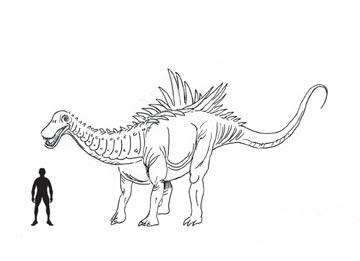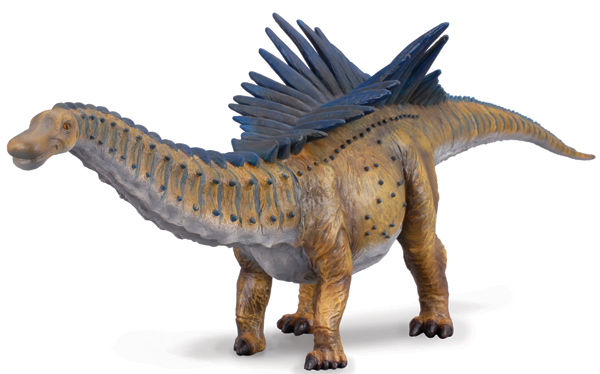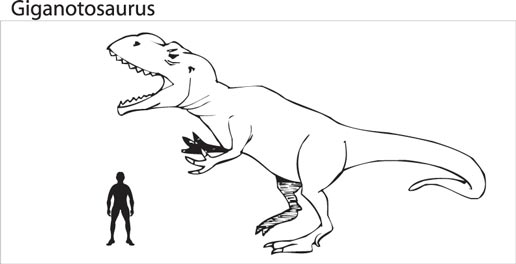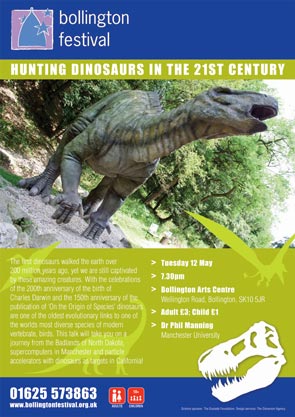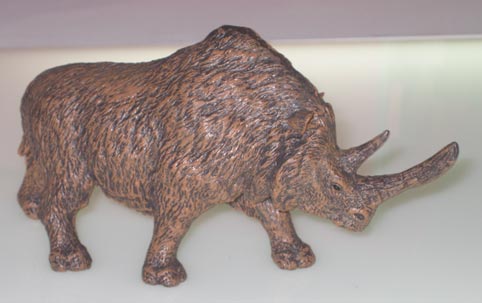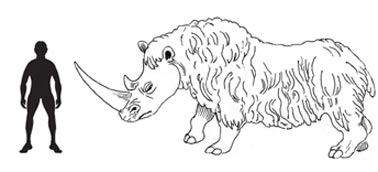Palaeontology with Computers – Powerful Computer Programmes provide New Interpretations
A few months ago, team members at Everything Dinosaur were privileged to be shown a life size cast of the sacral vertebrae and hip structure of a large North American theropod Acrocanthosaurus. We can’t remember the exact source of the cast, but we suspect it is of NCSM 14345 from the Black Hills Institute. We are fairly confident that the cast is from a paratype (a specimen not related to the holotype – the original material from which the animal was named and described).
Acrocanthosaurus
We were all rather blown away by the sheer size and scale of the animal. It is only when you get up close to casts like these and the real fossils themselves that you get an appreciation of just how sizeable some of these creatures were. There is only one species of Acrocanthosaurus recognised at present (A. atokensis), and it was certainly an apex predator, reaching lengths in excess of 12 metres and weighing more than 4 tonnes.
Complete articulated skeletons of dinosaurs are extremely rare, associated bones are like hen’s teeth but if a palaeontologist is lucky enough to find an almost intact fossil skeleton of an animal like Acrocanthosaurus, the fossil bones only tell half the story. A couple of new specimens of Acrocanthosaurus were discovered in the 1990s, more complete than the original holotype specimen excavated forty years earlier.
Theropod Fossils
Even so, fossils of large theropods are very special as when compared to the amount of hadrosaurine or even sauropod material in the fossil record they are amongst the rarest dinosaur fossils of all.
The fossilised bones of a complete skeleton can tell scientists a lot about the animal, but they do not make up the complete picture. With very little soft tissue such as skin, muscle, tendons and organs preserved scientists remain very much in the dark over key aspects of Dinosauria anatomy. When we visit classrooms we explain it using the analogy of a snooker table. Imagine you came across a snooker table, never having seen one before. You would see a large flat table, covered in green baize with six pockets spaced around it. It would be difficult to work out what the table was used for, unless you found the balls, snooker cues, spiders, triangle and all the other elements associated with the game as well.
Educated Guesses
Without the soft tissues, scientists have to make educated guesses, drawing conclusions on muscle size and fixation by studying the scars on bones that indicate muscle attachments.
The fossil bones may indicate where muscles were attached but they do not reveal information about the relative sizes, their length, thickness or composition. Left to making educated guesses palaeontologists can make widely varying assessments regarding dinosaur locomotion, gait, physical size and velocity.
For instance, if the muscles connected to the femur of a tyrannosaurid were short, this would suggest that the femur would have been angled more vertically in relation to the hip bones, as in human beings. However, if the muscles were longer, then the thigh bone would have resembled the more horizontal position as seen in Aves (birds).
Human Femur Position compared to Modern Bird Femur Position
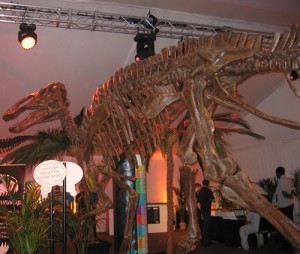
Duck-billed dinosaur on display. There is more to interpreting the anatomy of the Dinosauria than just simply examining their fossilised bones.
Picture credit: Everything Dinosaur
The photograph (above) shows an articulated specimen of the hadrosaur Edmontosaurus (E. annectens). There is much more to deduce about the anatomy of the dinosaurs than simply reconstructing their fossilised bones.
Powerful Computers and Software
A relatively new field of palaeontological study, the use of powerful computers to model concepts and create 3-D images is revolutionising the way in which soft tissue structures are visualised. Such work is being pioneered by a team of researchers based at Manchester University. Researchers such as Bill Sellers and palaeontologist Phil Manning create virtual muscles on scanned images of dinosaur bones to calculate how muscles worked and the anatomy of these long dead creatures.
The team from Manchester University create computer algorithms that carry out experiments to establish the most efficient method of locomotion for prehistoric animals. At first the programmes cause the specimen being modelled to fall over but gradually the computer programmes learn from their mistakes, correct them and come up with the most likely solution.
Explaining how the process works, computer palaeontologist Peter Falkingham of Manchester University stated:
“Initial attempts to randomly decipher which pattern of muscle activation works best result almost always in the animal falling on its face“.
However, the scientists employ “genetic algorithms,” or computer programmes that can alter themselves and evolve, and so run pattern after pattern until they get consistent improvements.
Eventually, they evolve a pattern of muscle activation with a stable gait and the dinosaur can walk, run, chase or graze, Falkingham added.
Mimicking Natural Selection
Assuming the Manchester team’s computer software is mimicking the process of natural selection, then the computer generated animal should move similar to its now extinct counterpart. By comparing their cyberspace results with real measurements of extant species such as humans and emus the Manchester team can be confident in the results computed for extinct prehistoric animals such as dinosaurs.
Now back to Acrocanthosaurus, this giant meat-eating dinosaur from the Early Cretaceous (Aptian to Albian faunal stages). Acrocanthosaurus was named after the tall neural spines that ran along the backbone, the function of these spines, some of which measure nearly three times the height of the vertebrae from which they project, is not known. Scientists have speculated that the spines are similar to those found in modern bison, these spines are used to support a hump that stores fat. Perhaps this large meat-eating dinosaur had a hump which allowed it to store fat and water reserves to help it survive times when food was scarce.
An Acrocanthosaurus Dinosaur Model

The Papo Acrocanthosaurus dinosaur model. A close-up view of a typical Acrocanthosaurus dinosaur replica.
Picture credit: Everything Dinosaur
The photograph (above), shows a reconstruction of the Papo model of Acrocanthosaurus atokensis. We noted that over the sacrum vertebrae there was extensive criss-crossing of tendons and other structures, as viewed by our team members when we viewed the cast of the Acrocanthosaurus fossil at Manchester University. In the model image, the Acrocanthosaurus although typical of an allosaurid in so many ways, would have had a distinct hump.
To view a scale model of Acrocanthosaurus, Allosaurus and other theropod dinosaurs: Dinosaur and Prehistoric Animal Models.
The Work of Peter Falkingham
Peter Falkingham specialises in using the computer algorithms to interpret fossilised trackways, unlike fossil bones that may be transported a long way from where the animal lived before being deposited, footprints and trackways are preserved “in situ”.
He went on to comment:
“Tracks can tell you so much that skeletons can’t. They can tell you about the soft parts of the feet that weren’t preserved over time. They can tell you how the animal moved, how it walked or ran. They can even tell you about the environment they lived in, and perhaps show you they may have moved considerable distances.”
Recreating Fossil Trackways
Recreating fossil trackways as manual models and experimenting on them to calculate how the animal actually walked would be very time consuming and accurate, consistent results would be difficult to achieve. However, by using the computer software a number of different scenarios can be tested and when this data is combined with aspects of anatomy, the locomotion and movement of a large dinosaur like Acrocanthosaurus can be better understood.
The Manchester University team have used the computer algorithms to study the way in which Acrocanthosaurus walked (fortunately there are some extensive trackways in the United States attributed to Acrocanthosaurus to assist in this research).
In this way, the team hope to shed some light as to the peculiar structure and purpose of the tall neural spines and structure of the bones making up the sacral vertebrae. Based on this work the team have “fleshed out” this dinosaur creating a muscle map of this large, stocky meat-eater.
A Reconstruction of an Acrocanthosaurus
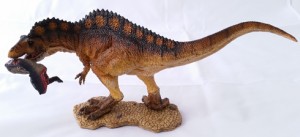
A great dinosaur model by Rebor (Acrocanthosaurus atokensis).
Picture credit: Everything Dinosaur
Neural Spines
The neural spines seem to be broader immediately behind the sacrum, could they have supported thicker muscles that may have helped counter balance the creature as it walked? Could the structures have acted as shock absorbers to steady the animal as it ran, or could they have stored some energy in the large tendons associated with this part of the skeleton and reduced energy expenditure as the animal moved in a similar way to the long tendons found in kangaroos.
Tendons as energy stores may not have enabled this animal to “bounce” along like a kangaroo but by tensing and relaxing they may have helped this particular dinosaur maintain momentum and expend less energy as it moved about.
Three Dimensional Images of Acrocanthosaurus
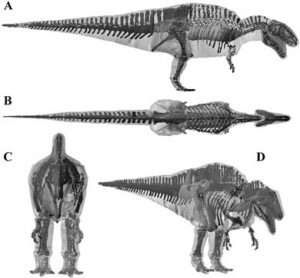
Computer models help bring Acrocanthosaurus back.
Picture credit: Bates, Sellers and Manning, University of Manchester
By viewing diagram A (lateral view) it can be seen how thick set and heavy this animal appears to be. It has a deep broad tail and powerful leg muscles to aid locomotion. It is interesting to note diagram C (anterior view), the skull is very narrow and the jaws delicate and fine. Light skulls are characteristic of Allosauridae but Acrocanthosaurus seems to have an out of proportion skull in comparison with its thick, heavy body. Perhaps this large theropod has more secrets about its anatomy and position in the Cretaceous food chain awaiting discovery.
The feet are also worthy of note, they look surprisingly small when compared to the size of the animal, perhaps the peculiar lacerations and scars found on the sacral vertebrae and neural spines of this dinosaur provide a clue to this phenomenon also.



